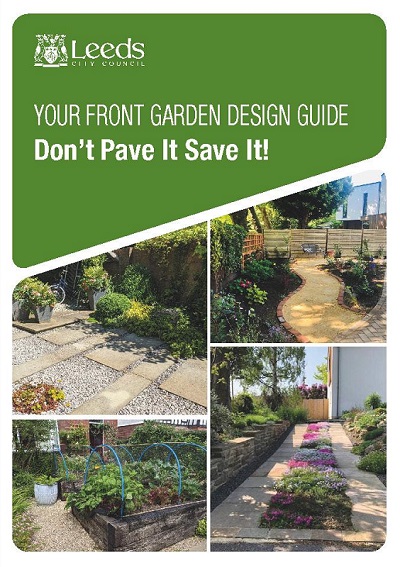Your front garden plays a variety of roles. It can be a place to play, to relax or to park your car. It also affects how your house and street look, provides a home for local wildlife and soaks up rainwater. More and more homeowners are paving over their front gardens to make space for cars and this can cause problems with drainage as well as loss of nature.
As part of its commitments to a Climate Emergency the council would like to encourage homeowners to think differently about their front gardens and if you need to park your car on it think about how to do that in a way which doesn’t make local flooding worse and which can also be good for nature.
Everyone can play a part in tackling Climate Change. Front gardens can help to limit Climate Change by retaining trees and plants which help soak up carbon. They also help us be more resilient to dealing with hotter and wetter weather.
Many of the drains in Leeds were built a long time ago and were not designed to cope with the increased rainfall that climate change brings. It is helpful to avoid as much water as possible from entering the drains and gardens play a role in that because they soak water up.
You might not think that paving one or two gardens would make a difference but as the trend continues there is an overall combined pressure being placed on our infrastructure and this can lead to more incidences of localised flooding.
But paving over front gardens is also about being resilient to climate change and helping the natural environment. Trees and plants not only absorb carbon, but they also lower the surrounding temperature because it catches the suns rays whereas asphalt raises the surrounding temperature because the sun’s rays bounce off it. This is called the ‘urban heat island effect’ and the more green space that we have in our urban areas the more resilient we will be to higher temperatures.
There are not many planning controls that the council can use to prevent the loss of front gardens to hard landscaping if it is permeable. So this guidance encourages home owners that need to make space for cars in front of their homes to think of greener design solutions, where attractive planting and parking can be combined. There will also be a continued need for driveways as electric charging points increase over the coming years, and it is expected that greener designs will also be incorporated in new housing developments.
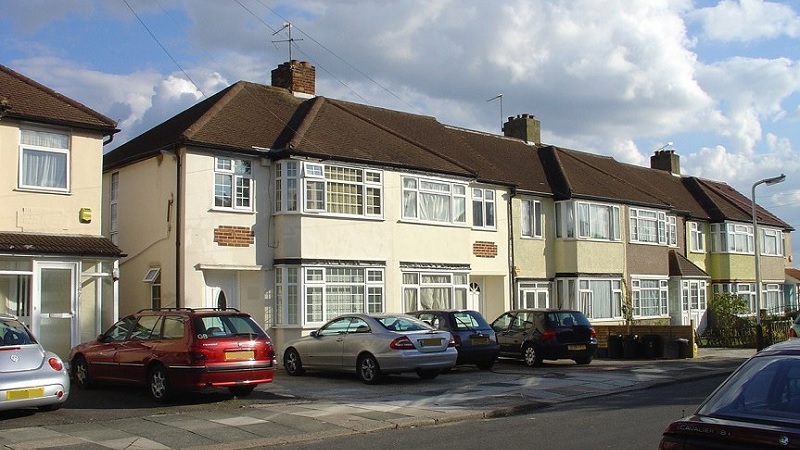
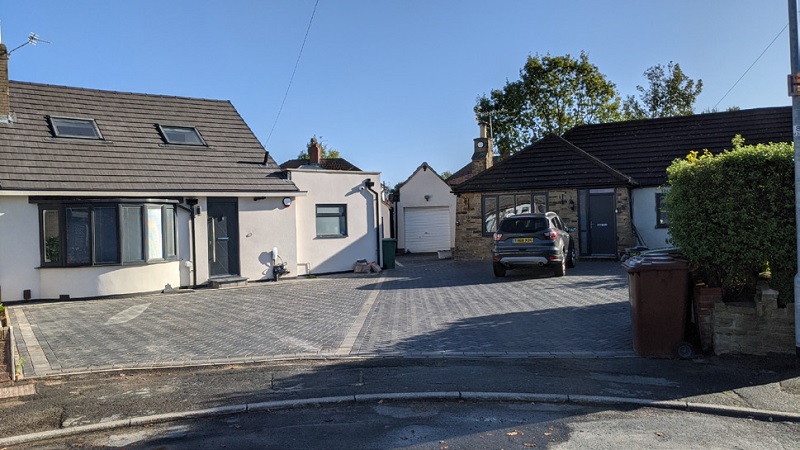
The council already takes measures to control water runoff and paving your front garden can be subject to council approval. Guidance Note 2 'Driveways front gardens and parking' sets out the rules around whether planning permission is required and the surfacing that is encouraged. It encourages use of permeable materials and run-offs so that water is managed well.
If vehicular access from a highway is needed, an application must be made for a ‘dropped kerb’ as it is illegal to build a crossing over a public footpath without council consent. The council will also require the kerb to be built to specific standards and must approve its construction.
This comes under Class F of the General Permitted Development Order which states:
F.2 Development is permitted by Class F subject to the condition that where:
- The hard surface would be situated on land between a wall forming the principal elevation of the dwellinghouse and a highway, and
- The area of ground covered by the hard surface, or the area of hard surface replaced, would exceed 5 square metres, either the hard surface is made of porous materials, or provision is made to direct runoff water from the hard surface to a permeable or porous area or surface (using green, vegetated areas; directing water from an impermeable surface to a soakaway or border; using permeable block paving, porous asphalt or concrete permeable hard surfacing like gravel, permeable block paving and porous asphalt of any size does not require planning permission because rainwater will be able to drain through it naturally) within the curtilage of the dwellinghouse.
However, keeping hard surfacing to a minimum will leave space for plants which can provide homes and food for wildlife, especially pollinators like bees, as well as being visually attractive and providing a green buffer to polluting roads.
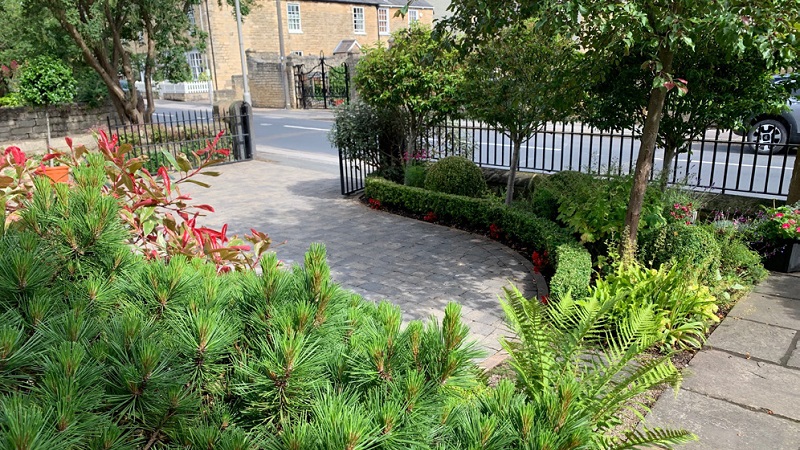

Allowing space for parking on a permeable gravel surface with lots of plants in the gaps.

Image 1 - RHS Demonstration Garden at Hampton Court Flower Show.
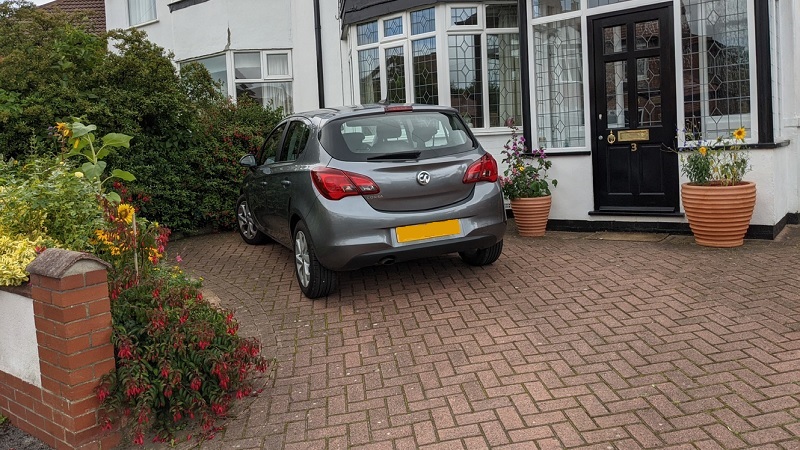
Image 2 - Even the smallest space can be green and inviting, while providing room for a car or two.
A few top tips
Use a hedge instead of a fence
Hedges can help protect the front garden from pollution and provide a home for wildlife. There are lots of low maintenance species like dark green Yew and Beech. Or choose something more colourful with berries like Berberis with the added benefit of providing a thorny hedge for security.

Plant under cars
If cars are frequently out for the day, low-growing plants that don't mind occasional knocks can be planted between the wheel tracks. Try Creeping Jenny (Lysimachia nummularia); Bugle (Ajuga reptans) and Thymes such as Thymus serpyllum. There are plants that thrive in the driest places and these are perfect choices in narrow strips.
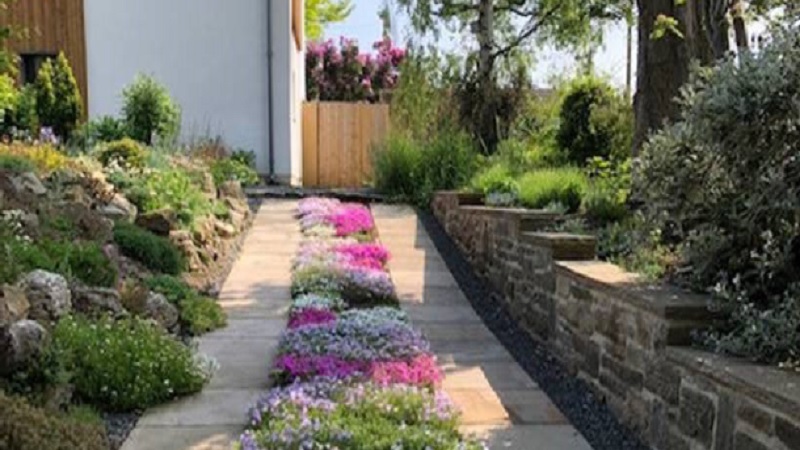
Image 1 - Roundhay eco-house planted with thyme.

Image 2 - RHS Harlow Carr demonstration garden with cycle shed.
Container garden or raised vegetable planters
Pots can be placed anywhere, allowing plants to be grown in areas of the front garden that don’t have soil. Choose plants that support pollinators for added biodiversity value such as Catmint (Nepeta), Wild marjoram (Origanum vulgare) and Geraniums. Raised planters can provide a productive growing garden.
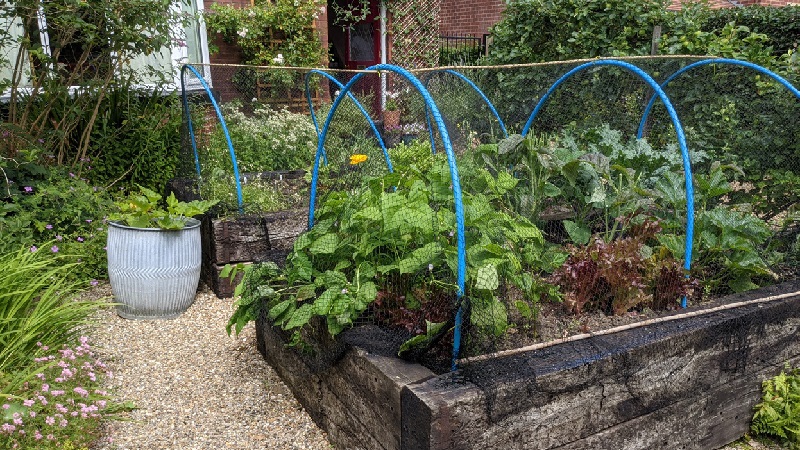

A choice of paving materials
Paving over your front garden affects far more than the environment on your doorstep. But it is possible to avoid some of the most damaging effects.
If you want to pave your front garden, choose a permeable surface, which allows rainwater to soak away into the ground. These include:
- permeable block paving (shaped with corner 'notches' to aid water runoff)
- porous poured surfaces (asphalt, resin-bound gravel)
- gravel (if the driveway is generally level - less than 1 in 40). However, gravel can spill or get dragged out onto the highway, so the first section (at least 2m) should be constructed in a different material. It is recommended that if a gravel driveway is the preferred option, a moulded plastic grid paving system is used which helps prevent the movement of gravel
- a separate pedestrian path (not loose gravel) will be required for wheelchair access and wheelie bins
- grasscrete (matrix paving) could be considered for larger areas of parking or parking courts
Front gardens in new developments
This guidance is applicable to new housing developments, to ensure that front gardens are designed alongside the same principles as existing housing. Although the green inspiration of the showhome's front garden is often not replicated in the houses for sale, it clearly shows that the housebuilder knows what will attract a potential buyer.
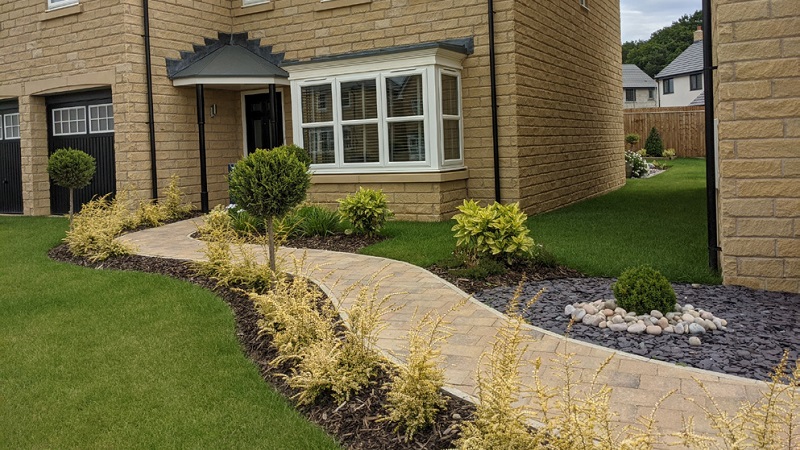
Image 1 - The show home.
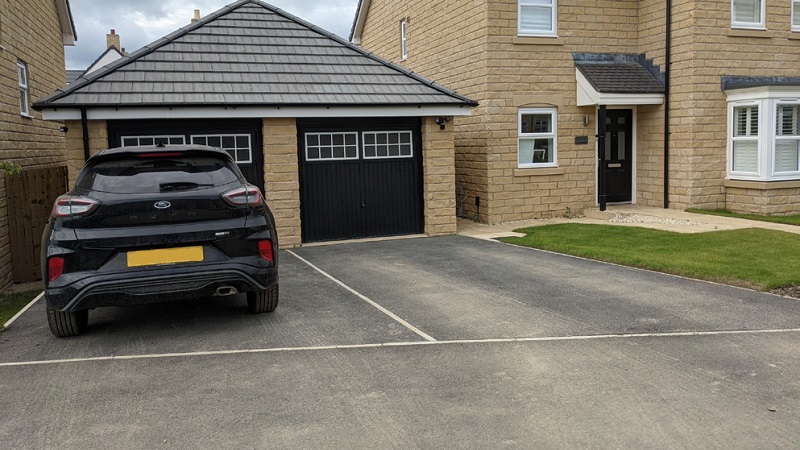
Image 2 - The reality.
Retention of existing trees within new gardens adds a sense of establishment and maturity to any new development. They can make a significant contribution to Sustainable Placemaking and assist in integrating any new development into its surroundings. In light of the LCC Climate Change Emergency, declared in 2019, existing trees are now being valued in terms of their carbon storage and their year-on-year carbon sequestration. This is in addition to public amenity and bio-diversity value, and also in terms of their contribution to air quality/ pollution.
In comparison, new tree planting offers little visually or environmentally (in the sense of carbon capture) for at least 20-30 years. A large mature tree can absorb and store in the region of 3.5 tonnes of CO2. Cutting one down releases the CO2 back into the atmosphere. Consideration must therefore be given to retaining existing trees in a sustainable manner.
Leeds University has estimated that trees across Leeds (exclusive of woodlands) took up the equivalent of 1% of the region's CO2 emissions in 2018.
But clearly we need new trees too, to replace ones that have come to the end of their life and to assist with mitigating the effects of climate change. But these could be smaller garden trees that have an important role in absorbing excess water and provide shade. Fruit trees are also a good addition to a front garden and have the benefit of attractive springtime blossom.
Although, as previously stated, we do not have a Local Plan policy on the use of porous paving in front gardens, we do have the Natural Resources and Waste Local Plan.
This states that permeable surfacing should be used for all extensive areas of hard standing (including car parks).
When the council is dealing with applications for new housing development we apply Policy Water 7: Surface Water Run-Off, of the Natural Resources and Waste Local Plan, to reduce the speed of surface water run off through the use of sustainable drainage wherever possible, including use of porous surfacing. The Policy states:
Water 7: Surface water run-off.
All developments are required to ensure no increase in the rate of surface water run-off to the existing formal drainage system. Development will be expected to incorporate sustainable drainage techniques wherever possible.
- on previously developed sites peak flow rates must be reduced by at least 30%
- on sites which have not previously been connected to the drainage infrastructure, or watercourse, surface water run off rates will not exceed the 'greenfield' run-off rate (i.e. the rate at which water flows over land which has not previously been developed)
Conservation areas
These are areas of ‘special architectural or historic interest’ which the council have named so they can be ‘preserved or enhanced’ (there are currently 26 Conservation Areas in Leeds).
Many are streets with buildings of a particular style and age, often with mature street trees and defined boundaries. Protecting existing trees and adding new ones contributes to retaining the special character of these areas, as does the retention of hedges and walls alongside the street as these relate to the style and period of the houses. The special character will be lost if front gardens and boundaries are removed.
In Conservation Areas it is particularly important to retain the original hard landscaping materials and use a sympathetic style.
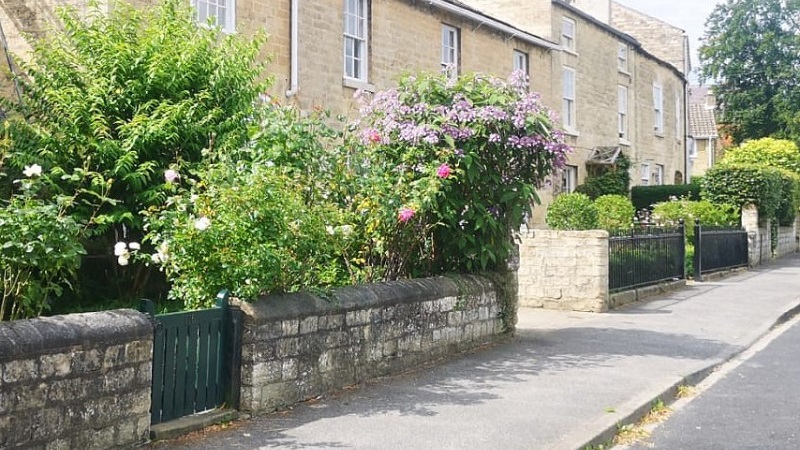
Gardening for wildlife
Urban front gardens of all sizes support a substantial range of wildlife including birds, butterflies, bees and hedgehogs, collectively making up a matrix of interlinked spaces for wildlife. Without trees and plants, there are fewer places for birds to nest and less feeding opportunity for pollinating insects and mammals.
Some animal species are now more common in towns than in rural areas and gardens increasingly provide urban residents with our only close encounters with the natural world. Habitat structures such as log and stone piles and bug hotels can be integrated into constructed elements or located in a quiet corner.
Keep your garden green
More and more of us are choosing to pave over our front gardens or swap natural grass for plastic grass (artificial turf). Let nature be nature by sticking to natural grass and avoid cutting down trees and hedges. Not only will wildlife love you for it, you’ll also reduce your risk of flash flooding. Click here for find more tips about gardening for wildlife.
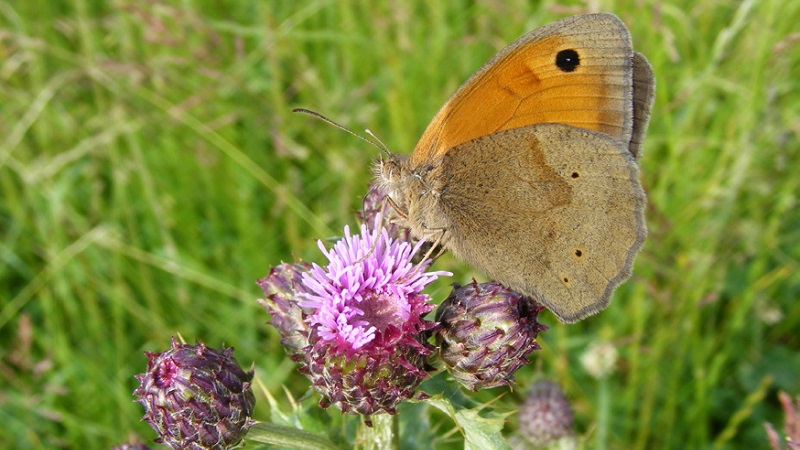
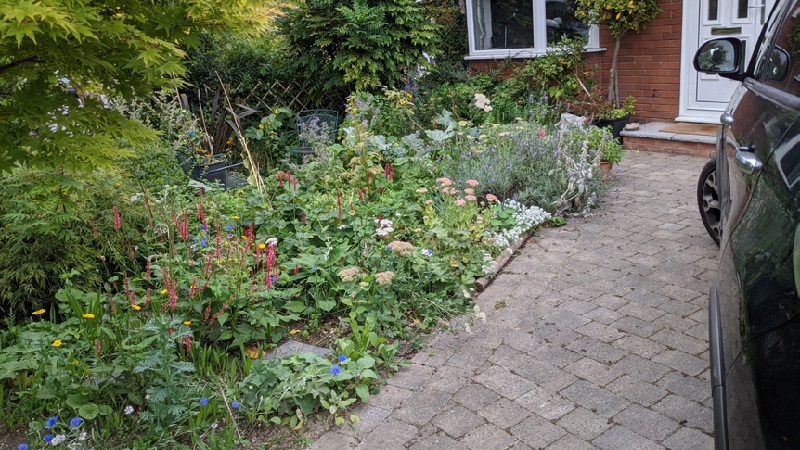
LCC's Climate Emergency newsletter of 6/10/20 highlighted the paving of front gardens and the benefits to wildlife in retaining greenery.
The Leeds by Example website also has some useful information on biodiversity.
Future proofing your 'lifetime home'
Future proofing your home enables you to live in it through your lifetime, so that it is fully accessible for wheelchair users and other disabled people. It should be noted that stepping stones and loose gravel are often inaccessible, as the wheels of mobility aids and sticks might get stuck. Bonded gravel is approved by BS8300 and may be more suitable, by maintaining a solid route from the highway to the main access into the property. This route can also serve the carparking space.
Planting can also be a concern for the blind and visually impaired where it overhangs a path or route, and also for disabled people using mobility aids where it creeps across a public highway and reduces the available width. Raised planting beds can often be an accessible form of gardening as well as enabling greater social interaction with neighbours and reducing feelings of isolation.
Further guidance on raised beds for wheelchair users and people who need to sit down whilst gardening can be found through Carry on Gardening.
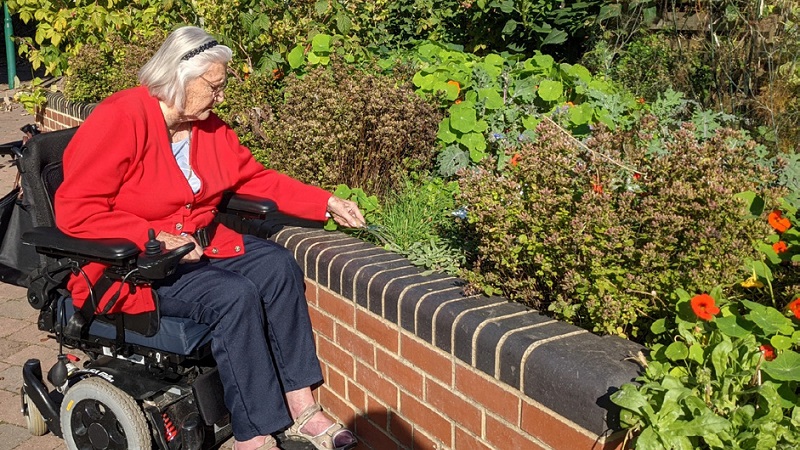
Raised planters at a convenient height for wheelchair access.
Some interesting facts:
- domestic gardens make up nearly half of the UK's urban green space
- they contain four out of five of the trees in our towns and cities, and thereby provide a key element of our green infrastructure
For a copy of Guidance Note 2 Driveways front gardens and parking please email FRM@leeds.gov.uk.
Improving Health and Wellbeing and addressing the Climate Emergency are priorities in the Council Plan 2020-25 and greening our streetscapes and neighbourhoods is key to achieving the ambition of a greener city.
Planning permission is required for traditional paving of an area bigger than 5 square metres that does not provide for the water to run to a permeable area like a lawn or border.
The Royal Horticultural Society has investigated the importance of our front gardens in their 'Front Gardens' guide.
Introducing pollinator friendly plants and permeable paving will give wildlife a home and reduce flood risk. A planted boundary will also absorb air pollutants from adjoining roads through the leaves of a hedge, thereby improving the air quality in our homes. The Royal Horticultural Society has advice on designing front gardens and which plants to choose.
More information on the problems of paving over front gardens and design solutions is available on the RHS website.
Evidence and references
The Urban Heat Island Effect
U.K. Climate Projections: Summer Daytime and Nighttime Urban Heat Island Changes in England's Major Cities
"Paved surfaces and reduced vegetation in urban areas limit latent heat loss through evapotranspiration, increasing the upward sensible heat flux that warms the urban boundary layer"
Estimation of the urban heat island for UK climate change projections
'The geometry of most urban areas (tall buildings and narrow streets) means that buildings provide large areas for absorption of heat but limit the ease with which the heat can be lost via radiation and convection (the 'canyon effect'). Urban areas are usually well drained, which limits the cooling effect of evaporation of water from the surface'
Soil surface temperatures reveal moderation of the urban heat island effect by trees and shrubs
'Urban greenspaces can mitigate the effects of the UHI by changing the surface energy balance of the system. Evapotranspiration from urban greenspaces can cool leaf surfaces and air temperature as the energy from solar radiation is stored as latent, rather than sensible heat'
The Leeds urban heat island and its implications for energy use and thermal comfort.
In Leeds, the area of paving in suburban front gardens was found to have increased by 138% between 1971 and 2004
A quarter of all gardens have been paved over nationally
Impact of paved front gardens on current and future urban flooding
The RHS report 'Greening Grey Britain' has more design guidance on materials to use
A last word about hard surfaces is that they absorb heat during the day and release it at night. Black asphalt absorbs solar radiation, resulting in excessive accumulated heat (D Yinfei - 2018). Plants have a cooling effect due to transpiration, they absorb CO2 and give off oxygen and water.
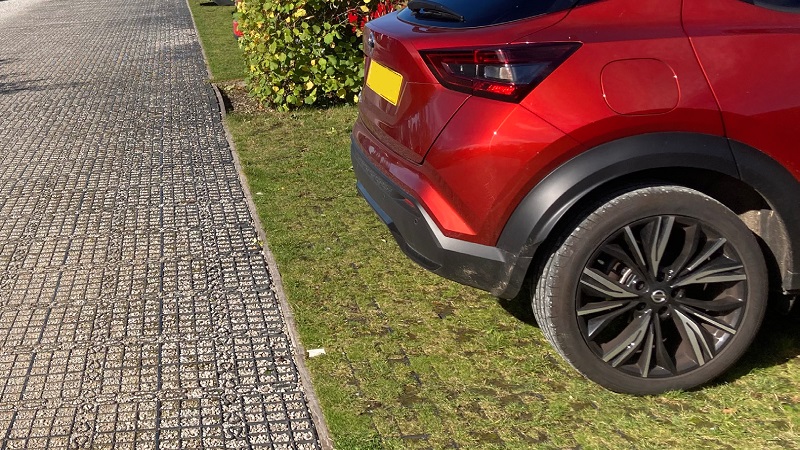
Matrix paving showing the parking area covered in grass while the main path uses gravel.

















